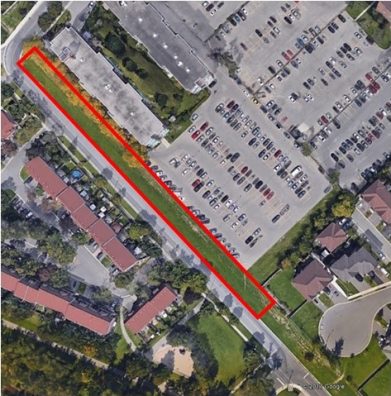Haggert Avenue Bioswale with Structural Soil Base – City of Brampton
The City of Brampton, in partnership with Credit Valley Conservation took an innovative approach to retrofitting Haggert Avenue, a local road in the Fletchers Creek SNAP neighbourhood, identified as a location for an early action project.
As water makes it way from roads to the nearest waterway, it picks up pollutants like oil, dirt and road salt. Green infrastructure and low impact development such as rain gardens and bioswales are sustainable landscaping technologies that manage rain and snowmelt to reduce the risks of flooding, improve the health of local rivers and streams and build local resilience in a changing climate.
The land beside Haggert Avenue (see Figure 1) has been transformed into a landscaped bioswale with native trees, grasses and flowering plants to help improve stormwater management in the neighbourhood. Instead of using traditional curb and gutter drainage, Haggert Ave was retrofitted during recent road repairs so that rainfall can drain to the bioswale before entering Fletcher’s Creek. The bioswale will slow down, soak up and filter rainwater. The bioswale uses an innovative approach, with structural soil (a soil and stone mixture) as the storage layer (see Figure 2). This ensures a consistent water storage volume is maintained overtime while providing space for the tree roots to grow. This project will help keep Fletchers Creek clean and protect fish such as the Redside Dace, an endangered fish species.
Most of the system was constructed in Fall 2020 with final plantings completed in 2021. The system was recently put online to begin filtering rainwater. CVC’s monitoring team will make regular site visits to assess the performance of the bioswale. Early results are positive and show that water can soak into the ground faster than originally expected!
Figure 1. Bioswale project location Figure 2. Simplified Schematic of Bioswale Design







